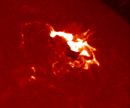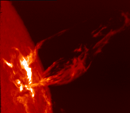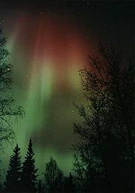The Sun is a "living, breathing" ball of gas that is continuously active. And, like many of the Earth's natural processes, the Sun's activity is cyclical (repeating over a period of time). This cycle is referred to by scientists as the "solar cycle." This activity on the Sun's surface——such as solar flares or coronal mass ejections (CMEs)——can greatly enhance the total energy carried by the solar wind, as well as its speed. It also affects the intensity of the interplanetary magnetic field (IMF).
Solar flares are tremendous explosions on the surface of the Sun. Coronal mass ejections (a collection of charged particles) are huge bubbles of coronal plasma threaded with intense magnetic field lines that are ejected from the Sun over several hours.
 |
 |
Solar Flares
|
Coronal Mass Ejections
|
 |
Aurora Photo
|
While Earth's magnetosphere deflects most solar activity carried by the solar wind, some charged particles seep through. These energetic particles cause magnetic disturbances, classified as either geomagnetic storms or substorms. These storms can be beautiful and benign, as when displayed in auroral light shows. However, they can also be devasting——causing damaging space weather.
Geomagnetic storms are classified as either "recurrent" or "non-recurrent." Recurrent storms, corresponding with the Sun's rotation, occur every 27 days. They are triggered by the Earth's encounter with the southward IMF, when high-pressure regions are formed by the interaction of low and high speed solar wind streams that co-rotate with the Sun. These recurring storms most frequently occur during the solar minimum, the declining phase of the solar cycle. Non-recurring storms frequently occur during the solar maximum, when the solar cycle is at a high peak. These storms are caused by coronal mass ejections (CMEs) (a collection of charged particles) and, typically, the CME's encounter with interplanetary shock waves.
The origin of substorms is similar to that of geomagnetic storms. But substorms are brief, lasting only two to three hours, and occur much more frequently——on an average, up to six times a day. Substorms occur during the main phase of storm growth. Substorms are observed only in the auroral zones, while magnetic storms are a world-wide phenomenon.
We know that major events of solar activity on the Sun are cyclical (repeat on a cycle). For example, maximum sunspot conditions occur about every 11 years and can last for several years at a time. As sunspot (dark areas caused by magnetic disturbances) groups grow rapidly, rotating like a hurricane, enormous explosive releases of energy create solar flares. And, even 93 million miles away many of the Earth's systems beat to the solar rhythm.